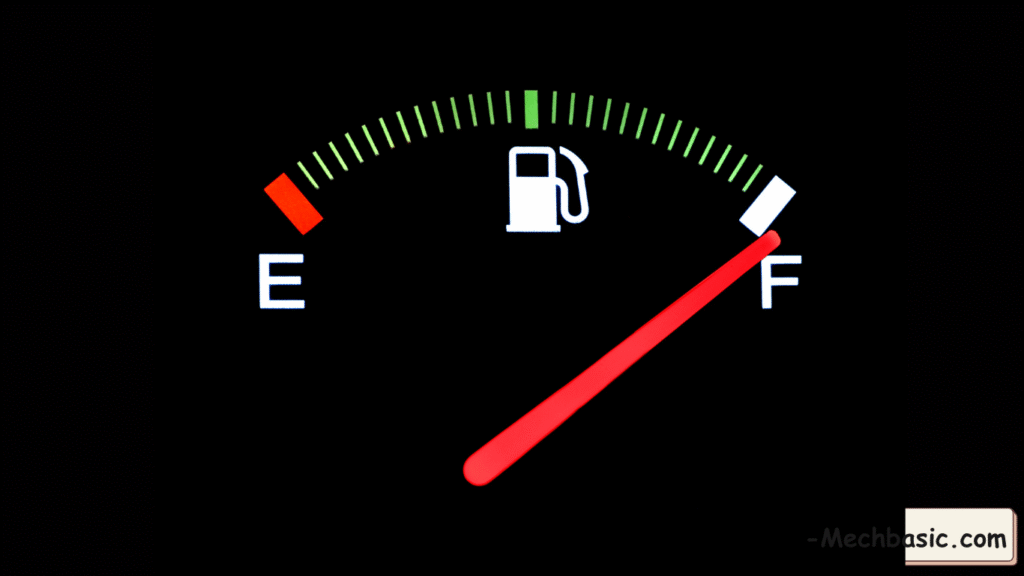Let’s go in detail about the fuel gauge in an automobile:
In this article:

1. What is a Fuel Gauge?
A fuel gauge is an instrument in a vehicle that displays the amount of fuel remaining in the fuel tank.
- Usually located on the dashboard, often near the speedometer or tachometer.
- Helps the driver monitor fuel levels to avoid running out of fuel unexpectedly.
2. Purpose of a Fuel Gauge
- Monitor Fuel Level: Shows how much fuel is left in the tank.
- Prevent Running Out of Fuel: Alerts driver to refuel before the tank is empty.
- Trip Planning: Helps plan fuel stops during long drives.
- Fuel Efficiency Tracking: Some digital fuel gauges integrate with trip computers to monitor fuel consumption.
3. Components of a Fuel Gauge System
| Component | Function |
|---|---|
| Fuel Sending Unit | Located in the fuel tank; measures fuel level using a float connected to a variable resistor (potentiometer) |
| Gauge / Indicator | Dashboard display, either analog (needle) or digital, showing fuel level |
| Wiring / Circuit | Transmits electrical signals from the sending unit to the gauge |
| Warning Light (Optional) | Illuminates when fuel level is critically low |
4. How a Fuel Gauge Works
A. Mechanical / Analog Fuel Gauge
- Float in the fuel tank rises or falls with fuel level.
- Float is connected to a variable resistor (potentiometer).
- Change in resistance alters the current sent to the dashboard gauge.
- Gauge needle moves to indicate fuel level (E = empty, F = full).
B. Digital / Electronic Fuel Gauge
- Fuel sending unit measures fuel level electronically.
- Sends signal to the ECU or dashboard display.
- Digital display shows fuel level as a bar graph or numeric percentage.
5. Fuel Gauge Symbols
- E (Empty): Fuel tank nearly empty.
- F (Full): Fuel tank full.
- Low Fuel Warning Light: Usually yellow/orange; alerts driver to refuel soon.
6. Common Problems with Fuel Gauges
| Problem | Possible Cause |
|---|---|
| Gauge stuck at empty or full | Faulty sending unit, wiring issue, or gauge failure |
| Inaccurate readings | Float stuck, debris in tank, electronic sensor malfunction |
| Low fuel light not coming on | Burnt bulb, sensor failure, wiring issue |
| Erratic readings | Loose connections, electrical interference |
7. Importance of a Fuel Gauge
- Prevents running out of fuel in unsafe situations.
- Helps maintain fuel efficiency by allowing timely refueling.
- Protects fuel pump: Running completely empty can damage the fuel pump in many vehicles.
- Assists in trip planning and navigation, especially on long drives.
✅ Summary
- Fuel gauge = instrument showing how much fuel is left in the tank.
- Components: Fuel sending unit (float + resistor), gauge, wiring, optional warning light.
- Types: Mechanical (analog) or electronic/digital.
- Purpose: Safety, fuel management, maintenance, trip planning.
- Common problems: Faulty sensor, stuck float, inaccurate readings, low fuel light failure.
💡 Tip:
Never rely solely on the low fuel warning; keep the tank above 1/4 full to prevent fuel pump damage and ensure safe driving.
FAQ Section:
Here are 10 frequently asked questions (FAQs) about a Fuel Gauge in an Automobile:
- What is a Fuel Gauge?
A fuel gauge is an instrument that indicates the amount of fuel remaining in a vehicle’s tank. - How does a Fuel Gauge work?
It works using a float inside the tank connected to a variable resistor, which sends a signal to the gauge on the dashboard. - What are the types of Fuel Gauges?
The main types are mechanical (resistor and float-based) and electronic (sensor and digital display). - Why is a Fuel Gauge important?
It helps drivers monitor fuel levels to avoid running out and plan refueling efficiently. - Can a Fuel Gauge be inaccurate?
Yes, factors like faulty sensors, wiring issues, or sloshing fuel can cause inaccurate readings. - What does the “E” and “F” on the Fuel Gauge mean?
“E” stands for Empty, and “F” stands for Full. - Does the Fuel Gauge measure exact fuel quantity?
It gives an approximate level rather than precise measurement, often showing increments like ¼, ½, and ¾ full. - Can a Fuel Gauge be repaired?
Yes, faulty floats, resistors, or sensors can be replaced to restore accurate readings. - What is a low fuel warning light?
It’s an alert that activates when the fuel level drops below a certain threshold, prompting the driver to refuel. - Do modern cars have digital Fuel Gauges?
Yes, most modern vehicles use electronic sensors and digital displays for more precise and reliable fuel measurement.
Other courses:



